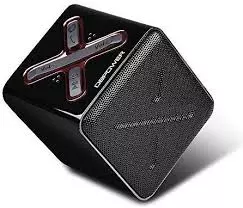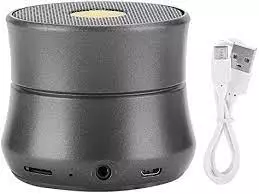Applications of Zinc Alloy in Bluetooth Speakers
 The history of Bluetooth speakers
The history of Bluetooth speakersIn 1994, Ericsson created the Bluetooth technology. The early Bluetooth technology was not very good: the transmission speed was not fast and the range was not wide. Not every device can be connected to the Bluetooth device and a device with the Bluetooth function many not transmit data because of the version and compatibility. However, with the rapid development of technology, the Bluetooth technology is also improving, from the initial version 1.0 to the current version 4.0, from a range of 10 meters to about 100 meters, and its transmission speed has also been greatly improved. Moreover, current Bluetooth devices also support the Advanced Audio Transmission Protocol (A2DP), which can transmit sound without damage and greatly reduce power consumption, and audio frequency with no damage is truly realized.
The NFC function that is also known as the near-field wireless communication technology, which was jointly developed by Philips Semiconductors, Nokia and Sony. As early as 2012, Google released a mobile phone with the NFC function. This technology is widely used in mobile payment, smart control tools and other near-field wireless communication technology.
With the support of these two technologies, Bluetooth speakers have inherent advantages in promotion. At present, mainstream digital products have built-in Bluetooth functions and the NFC near-field wireless communication technology. The Bluetooth speaker can be connected to any device that supports Bluetooth, which has good compatibility and can be used across platforms and systems. The NFC function can eliminate interference and simplify the connection. The Bluetooth speaker can connect to the device only by putting the two devices close to each other. In addition, when the Bluetooth speaker is within the working range, it can be automatically connected again, avoiding the trouble of manual connection again.
Bluetooth speakers have quietly become popular recently. There are some reasons: their cross-platform nature can make the Bluetooth speaker not restricted by the change of the socket and the Bluetooth power consumption is low. It is undoubtedly good news for the smart phone that needs to be charged twice a day, and there is no need to worry about the much power consumption because of connecting to Bluetooth speakers.
 The materials for producing Bluetooth speakers
The materials for producing Bluetooth speakersThe selection of Bluetooth speaks' materials is also one of the reasons why Bluetooth speakers are quietly popular. Plastics won't be chosen for the Bluetooth's shell material. One reason is the sound quality; the other reason is that the corrosion resistance and impact resistance of the ordinary plastic are not good and its texture is not as good as other materials. Wood is a good choice for speakers originally. Wood is used for traditional speakers. Speakers made of wood have good sound quality and texture. However, there are some disadvantages of speakers made of wood: the heat dissipation of wood being not very good, wood not being able to cope with the changeable shapes and costs being too high. Alloys, especially zinc alloy die casting products have begun to occupy the shell market of Bluetooth speaker accessories due to these reasons. Zinc alloy die casting parts are not light or heavy, and have good texture as the housing of Bluetooth speakers. Zinc alloy has good heat dissipation performance, and the general heating problem of electronic components can be well improved. Zinc alloy has good corrosion resistance after surface treatment. The most important thing is that zinc alloys can be designed in a variety of shapes and are easy to have a surface treatment. Bluetooth speakers can be taken with you, used in the car or exercise, and their prices ranging from a civilian price of dozens of RMB to a high-end market of several thousand RMB. Last year, the growth rate of Bluetooth speakers reached 170%. Bluetooth speakers have quietly become popular and rapidly occupied the market.